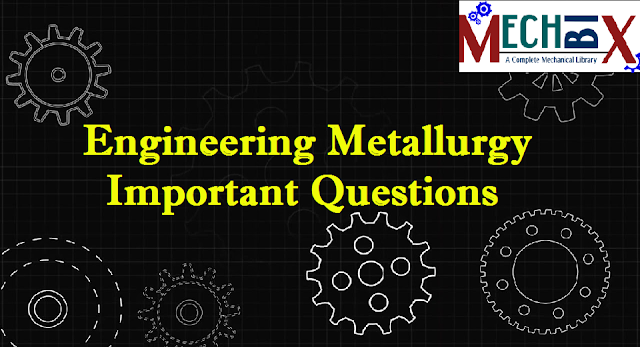Engineering Metallurgy Important Questions for AU Apr May 2020 Exams
ANNA UNIVERSITY THEORY EXAMINATIONS APR - MAY 2020
POSSIBLE QUESTIONS SET
ME6403 / ME8491 – ENGINEERING METALLURGY
(Reg 2013 / Reg 2017)
UNIT I
1. Explain the following invariant reactions with reference to a phase diagram (a) Eutectic reaction (b) Eutectoid reaction (c) Peretectic reaction (d) Peritectoid reaction.
2. Draw Iron-Iron carbide equilibrium diagram and mark on it all salient Temperatures and composition fields.
3. Explain in brief the properties and applications of cast Iron types.
4. Draw Fe-C diagram and mark all the phases and explain the reactions?
5. Draw a hypothetical phase diagram A-B with the help of following data: (a) Melting point of A = 1100°C (b) Melting point of B = 1300°C (c) Eutectic reaction occurs at 1000°C at 40% B composition. (d) maximum solubility of B in A and A in B at eutectic temperature in 10% and 5% respectively which drops down to zero at 0°C. Mark each line and area. How the structure of alloy will change if alloy containing 10% B composition is cooled from liquid state?
6. i) Draw the phase diagram between A and B, if the two metals are completely soluble in solid and liquid state.
ii) Discuss the similarities and differences between substitutional and interstitial solid solution?
UNIT II
7. Explain the difference between TTT diagram and iron –carbon equilibrium diagram.
8. Explain different types of tempering process.
9. With a schematic layout explain the following: Vacuum and Plasma hardening.
10. What is a CCT diagram? Describe various cooling curves on CCT diagrams. How such curves are drawn? Write short notes on critical cooling rate.
11. Explain hardenability and how Jominy end quench test is used for determining the hardenability of steels.
UNIT III
12. Classify stainless steel and tool steel and explain them in detail.
13. With part of phase diagram and relevant graphs, explain precipitation hardening treatment of AL-CU alloy.
14. Explain Ni based super alloys and Ti alloys.
15. Discuss the composition, properties, application of Malleable and Spheroidal cast irons.
16. Discuss the composition, properties and typical application of any four copper alloys.
UNIT IV
17. What is polymerization? Describe addition polymerization and condensation polymerization.
18. What are the special properties of plastics that make them suitable for engineering applications? Describe the concept of ‘Co-polymerization’.
19. Explain the properties and applications of the following polymers and discuss anyone fabrication methods of polymers. (i) PMMA (ii) PP (iii) ABS and (iv) Glass.
20. With the schematic diagram illustrate the processing of metal matrix composites.
21. Write short notes on particle reinforced composites and fibre reinforced composites.
22. What are the engineering ceramics and formulate the characteristic and classification of engineering ceramics.
UNIT V
23. Explain the mechanism of plastic deformation of metals by slip and twinning.
24. Write an engineering brief about the creep test? Draw a typical creep curve and explain the various stages of creep.
25. What are the different types of fractures in metallic materials? Formulate the important features of these fractured surfaces. What is the use of this study?
26. Draw the engineering stress – strain curve for mild steel, aluminium and cast iron. Discuss the tensile test and different mechanical properties obtained in tensile testing.
27. Describe Brinell hardness test and Rockwell hardness test to determine the hardness of a metal.
28. The following data were obtained in a tensile test on a specimen of 16mm diameter with a 55mm gauge length : The specimen diameter after fracture was 12.75mm Determine : 1.Tensile strength 2.Young's modulus 3.0.2% Proof stress 4.%Elongation 5.% Reduction in area
These are the most expected questions for University exam. There are chances of asking some other questions.



